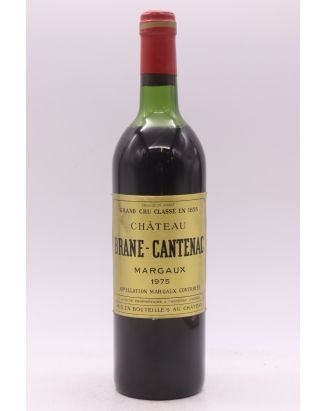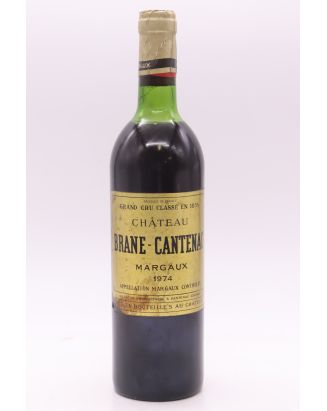








Founded in the 18th century under the name Château Gorce, the estate took off when it was purchased in 1833 by Baron Jacques-Maxime de Brane, nicknamed the "Napoleon of the vines". This visionary completely restructured the property and gave it the name Château Brane-Cantenac. He highlighted the richness of its terroir, propelling the estate to the rank of Second Grand Cru Classé during the famous 1855 classification.
The château passed through several hands before joining the Lurton family in 1925. Lucien Lurton took the reins in 1956 and continued the family tradition with passion. However, it was his son Henri Lurton, who arrived in 1996, who breathed new life into the estate. Thanks to major investments in cellar infrastructure and modernisation of viticultural practices, Château Brane-Cantenac is now considered one of the jewels of the Margaux appellation.
The 2019 vintage of Château Brane-Cantenac has been distinguished by Robert Parker with a 97/100, illustrating the great quality of this Margaux of character and the finesse of its aromas.
Château Brane-Cantenac benefits from an exceptional terroir located on the Brane plateau, on the left bank, the highest point of the Margaux appellation. This plateau is composed of quaternary gravel, with subsoils of mendel and günz, which allows for excellent water regulation and optimal grape maturation. The vines, with a planting density of 6,500 to 8,000 vines per hectare, extend over 75 hectares, of which 72 are dedicated to red wine production.
The vineyard, planted mainly with Cabernet Sauvignon (55%), Merlot (40%), Cabernet Franc (5%) and a touch of Carmenère, benefits from rigorous care to ensure the best expression of the terroir. The vines are on average 35 years old, an ideal age for producing concentrated and balanced grapes. Since 2010, part of the vineyard (10 hectares) has been cultivated using organic viticulture, demonstrating the estate's commitment to sustainable and environmentally friendly viticulture.
Vinification at Château Brane-Cantenac combines traditional methods with cutting-edge techniques. The grapes, carefully harvested by hand, are lightly crushed before being transported by gravity into vats. This gentle approach preserves the integrity of the berries and optimises the quality of the must. The estate has a modern vat room, composed of equal parts wooden, concrete and stainless steel vats, allowing for precise management of fermentations and optimal temperature control.
One of the estate's key innovations is the use of the "R'Pulse" system. This process injects air into the vats to gently stir the grape skins and seeds, thus promoting a soft extraction of aromas and colours without resorting to aggressive mechanical contact. This method allows for more intense and deeper wines, while avoiding the introduction of hard or overpowering tannins.
Another crucial aspect of vinification is pressing. Château Brane-Cantenac considers press wine (the juice extracted from the skins after pressing) as an essential element of the blend. Through meticulous programming of pressure cycles, the estate extracts three distinct qualities of juice, each kept separately before blending. This process adds complexity to the wines while preserving the finesse and elegance that characterise the house style.
Château Brane-Cantenac produces several cuvées, all imbued with the unique spirit of the Margaux appellation:
Château Brane-Cantenac: The estate's grand vin, composed mainly of Cabernet Sauvignon, with Merlot and a touch of Cabernet Franc. It is distinguished by its finesse, depth and perfect balance between power and elegance. It is aged for 18 months in barrels, 60 to 70% of which are new oak, giving it a silky tannic structure and beautiful aromatic complexity.
Baron de Brane: The estate's second wine, made from young vines. Less powerful than the grand vin, it offers a beautiful expression of the Margaux terroir with fruity and floral aromas. It is an accessible, elegant and delicious wine, perfect for more casual tasting.
Margaux de Brane: The estate's third wine, it presents a fruity and supple profile with melted tannins. Ideal for more immediate consumption, it reflects the soul of Château Brane-Cantenac with a lighter and easier to appreciate approach.
Brane-Cantenac Blanc: The estate also produces a small quantity of white wine, made from Sauvignon Blanc, Sauvignon Gris and Sémillon grapes. This Bordeaux white wine is fresh, lively and aromatic, with floral and fruity notes.
The finest vintages of Margaux, one of Bordeaux's most prestigious wines, are renowned for their finesse and elegance. Among the most remarkable years are 1959, 1983, 1986, 1990, 1995, 1996 and 1999, celebrated for their complexity and longevity. Recent vintages such as 2000, 2005, 2008, 2009, 2010, 2014, 2015, and 2016 are also highly regarded for their structure and richness. Other years such as 2017, 2018, 2019, and 2020 confirm Margaux's consistency in producing exceptional wines, symbolising Bordeaux excellence.
The Second Growths of 1855 constitute a prestigious category, grouping together iconic estates that often rival the First Growths in quality. Among them, discover Château Brane-Cantenac and Château Durfort-Vivens, both located in Margaux, as well as Château Lascombes, Château Rauzan-Ségla, and Château Rauzan-Gassies. In Saint-Julien, wine enthusiasts will appreciate the wines from Château Ducru-Beaucaillou, Château Léoville Las Cases, Château Gruaud Larose, and the famous Château Léoville Poyferré and Château Léoville Barton. Don't miss Château Cos d'Estournel and Château Montrose in Saint-Estèphe, as well as the essential Château Pichon Longueville Baron and Château Pichon Longueville Comtesse de Lalande in Pauillac.
With a rich history, exceptional terroir and avant-garde vinification techniques, Château Brane-Cantenac stands out as a must-have in the Margaux appellation. Its cuvées, always imbued with elegance and complexity, reflect the excellence of the estate. For lovers of great Médoc wines, it is a name to know and savour.